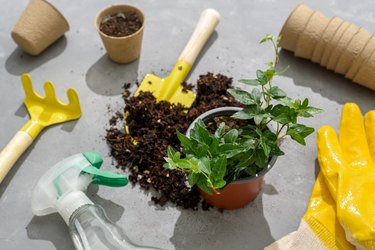
Indoor vine plants, including types of indoor ivy such as English ivy (Hedera helix, USDA zones 4 through 9) are popular as houseplants. The low height of English ivy's evergreen foliage but sprawling, dangling stems add grace to home decor. Over time, however, they eventually reach lengths that require trimming.
Reducing stem length on these indoor plants with hand pruners or household scissors is easily accomplished and can be a proactive measure done every spring to ensure the ivy remains an appropriate size. If your ivy is growing on a topiary form, the Clemson Cooperative Extension notes that you'll need to prune it more frequently than once a year to keep its shape.
Video of the Day
Video of the Day
Step 1: When to Trim Indoor Ivy
Avoid pruning the ivy houseplant in the short days of winter. The plant naturally slows its growth at this time of year and will not respond quickly with new leaves and stems. However, if the size of the ivy warrants immediate trimming, expect little regrowth from a wintertime pruning until the earliest weeks of spring.
Step 2: Determine Which Stems to Trim
Evaluate the ivy plant. Determine which stems are too long, are devoid of leaves, may be diseased or entirely dead. Some stems may have one or two leaves that need removal because of discoloration or being dead.
Step 3: Trim Dead and Diseased Parts
Trim dead or diseased stems with hand pruners or household scissors by clipping the stem 1/4 inch above a leaf or node, the scaled bump or scar left by an old leaf. Remove individual leaves on stems as needed if you see they are also dead or plagued with mold or an insect.
Step 4: Shorten Long Ivy Stems
Reduce the length of the undesirably long stems back to 6 inches shorter than a perfect length. For example, a stem may be 36 inches long, and you wish to reduce it to 24 inches in length. Plan on making the pruning cut at 18 inches, snipping the stem 1/4 inch above a leaf or node. The Missouri Botanical Garden notes that English ivy's long trailing stems can be featured in hanging baskets, so you may want to let these stems grow longer than, for example, a specimen that's growing in a dish garden.
Step 5: Trim Ivy for Aesthetics
Scan the plant after the initial round of trimmings. Turn the container and look for balance and overall attractiveness of the plant. If stems or leaves remain that are too long or brown, trim them as per Steps 1 to 3.
Step 6: Fertilize Ivy After Trimming
Fertilize lightly with a balanced houseplant fertilizer, such as 10-10-10, at half the dosage rate per label directions. Granular or liquid fertilizer is acceptable. If pruning is done in early spring, fertilize at the full dosage per the label directions.
Tip
Annual pruning maintenance on your ivy vine is ideally conducted in early spring, just before the plant would naturally increase its growth. Trimming results in side buds to form new stem tips, creating a specimen plant that is fuller, with more leaves and graceful branches.
Low ambient humidity in the home can cause foliage and stem tips to brown readily. Increase humidity by grouping houseplants near one another or setting the container atop a small tray of pebbles filled with water.
Warning
Do not over water houseplants; it promotes fungal diseases and root rot. Ivy appreciates an evenly moist soil, never bone dry or soggy wet.
Things You'll Need
Hand pruners
Scissors